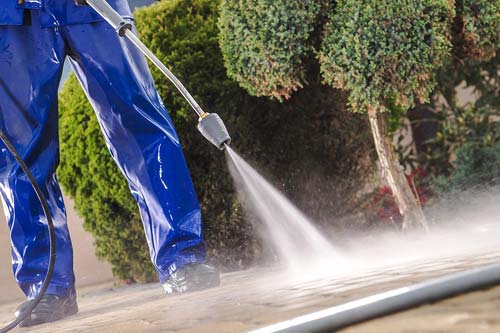There are some things to keep in mind when looking to pressure wash your block paving. If you follow these simple rules and guidelines, then you’ll be able to pressure wash your block paving as efficiently and as safely as possible:
Pressure washing your block paving is a stress-free way to make it look as good as the day it was laid. But to avoid damaging the bricks, make sure you use your pressure washer at an angle if you are using the wand attachment.
Preparation is key to any job throughout the home, whether you’re decorating the inside or transforming the outside. Take the time to sweep away any dirt and debris, including stones and other similar materials. This will prevent them from being caught by the jet washer and flung up into windows, cars or even yourself.
This will help to ensure you’re not overworking one area or spending energy going back over areas that you’ve already done. Start in one place and move down the block paving. This will also be handy for sweeping and draining away any excess water.
There will be a lot of excess water around, so make sure that you’re sweeping it away as and when it’s being collected. This is particularly important when the water is dirty because you don’t want it to dry on your freshly-washed block paving.
A specialist jet washing cleaner will help to lift dirt more easily. Where just the water stream will seem to be effective, it’s not actually cleansing the bricks whereas, as the name would suggest, a cleaner would. Do some research and pick up the most reasonably-priced product that’s got the best reviews and you’ll soon see a difference.
Rotary heads on a pressure washer are a time-saver. They’re able to cover a larger area in comparison to a simple wand attachment, so make sure you have one of those handy. It might have come with your jet wash or, if not, you’ll have to go out and buy one, but they can be easily found in your local hardware store or garden centre.
Just as there are some rules you should follow for pressure washing your block paving, there are some things you should avoid if you want to ensure safety and prevent damage to your house, car or other possessions. Here are the don’ts of pressure washing your driveway:
Block paving is laid on sand in order to prevent weeds, grass and other plant life from protruding up through the paving. This is because it can look unsightly and you don’t want those plants to take the moisture out of the ground below as this could lead to uneven bricks over time. Make sure you don’t take too much of the sand out whilst pressure washing block paving. If you do, be sure to push sand back into it. Fine sand is needed for this and it can be bought at your local hardware shop.
It can be very satisfying looking at clean, fresh block paving, which means it can be tempting to do it regularly. Don’t do it too often because it could cause permanent damage or scarring on your brickwork. It may also take the colour out of the bricks, exposing its natural colour underneath. Usually, pressure washing is done once a year.
We’ve already touched on this, but make sure that all stones and pebbles have been cleared away from the area before you start the pressure washing process. The same also goes for plant pots because they can break quite easily if caught by the water stream, depending on the pressure you have the washer one, of course.
This is imperative if you want to keep your car intact. Where you have probably made an effort to remove all stones from the area, there are bound to be some in the vicinity. If these are picked up by the jet wash, then it could fling up and hit your car, whether it be the body or the windows, leaving you with a large repair bill. Be safe and park your car somewhere else for the time being.
If you let dirty water gather and pool in one area and it subsequently dries, you’ll find that you’ll still have a particularly dirty patch of block paving. Prevent this from happening by sweeping the water away, down the nearest drain.
Here are a few other things you should keep in mind when pressure washing your block paving:
Move the pressure washer in a back and forth motion, rather than up and down. This will help to prevent streaking and ensure that all the dirt is removed. If you’re using a chemical cleaner, make sure to follow the instructions on the label carefully. This will help you avoid damaging your block paving.
Once you’re finished pressure washing, it’s important to rinse off any remaining cleaner with clean water. You don’t want to leave any residue behind, as this can cause dirt to build up in the future. Once you’re done, your block paving should look good as new.
